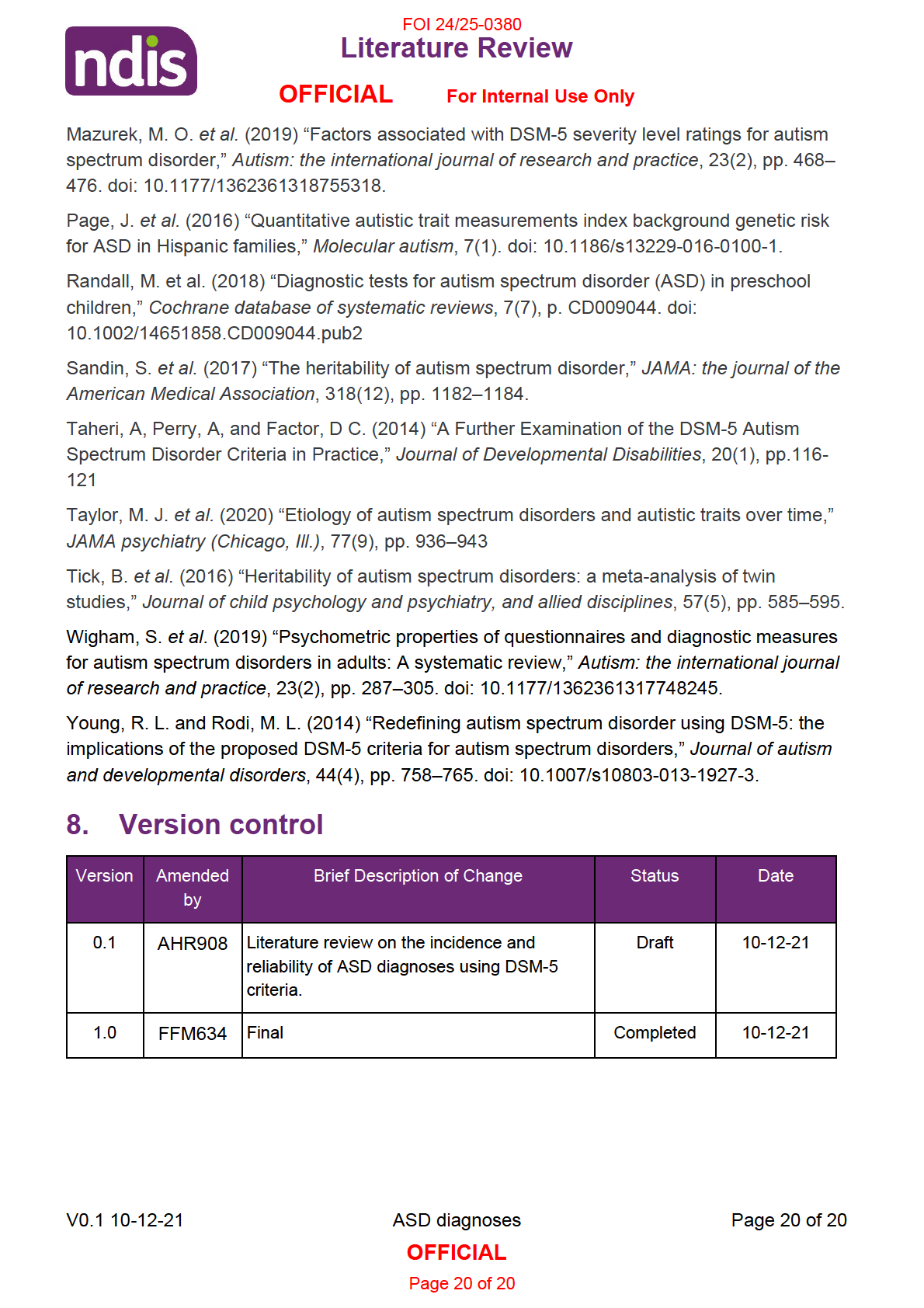
FOI 24/25-0380
Literature Review
DOCUMENT 9
OFFICIAL
For Internal Use Only
Diagnoses of Autism Spectrum Disorder using
the DSM-5
The content of this document is OFFICIAL.
Please note:
The research and literature reviews collated by our TAB Research Team are not to be
shared external to the Branch. These are for internal TAB use only and are intended to
assist our advisors with their reasonable and necessary decision-making.
Delegates have access to a wide variety of comprehensive guidance material. If
Delegates require further information on access or planning matters they are to call the
TAPS line for advice.
The Research Team are unable to ensure that the information listed below provides an
accurate & up-to-date snapshot of these matters
Research questions:
1. What is the accuracy of Autism Spectrum Disorder diagnoses using the DSM 5,
particulary for ASD levels 2 and 3 and particularly focussing on the interrater reliability of
single discipline assessments?
2. What is the incidence of ASD diagnosis among family members? How likely is it that
multiple siblings in a family will all have Autism Spectrum Disorder?
3. How has the rate of diagnosis of ASD changed since the publication of the DSM 5
diagnostic criteria?
Date: 10/12/2021
Requestor: S47F - Personal
Privacy
Endorsed by (EL1 or above): S47F - Personal
Privacy
Cleared by:
S47F - Personal
Privacy
1. Contents
Diagnoses of Autism Spectrum Disorder using the DSM-5 ........................................................ 1
1.
Contents ....................................................................................................................... 1
2.
Summary ...................................................................................................................... 2
3.
Frequency of ASD diagnoses in families ...................................................................... 2
4.
Accuracy and inter-rater reliability of ASD diagnoses using DSM-5.............................. 3
V0.1 10-12-21
ASD diagnoses
Page 1 of 20
OFFICIAL
Page 1 of 20

FOI 24/25-0380
Literature Review
OFFICIAL
For Internal Use Only
5.
Influence of DSM-5 ASD criteria on the prevalence of ASD ......................................... 4
6.
Literature Summary ...................................................................................................... 6
7.
References ................................................................................................................. 19
8.
Version control ............................................................................................................ 20
2. Summary
This literature review addresses questions relating to the prevalence of Autism Spectrum
Disorder (ASD). Findings include:
• ASD is strongly genetic. If someone has a family with ASD it is more likely that they
will be diagnosed with ASD and it is more likely they will display autistic traits even if
they don’t meet the threshold for a diagnosis.
• DSM-5 diagnoses of ASD are overall more accurate than DSM-IV diagnoses. A true
positive diagnosis is more likely if multiple assessment tools are used in the context
of a multi-disciplinary team.
• The changes to DSM-5 ASD criteria likely reduced the frequency of ASD diagnoses,
although prevalence continues to rise as a result of other factors.
These findings are provisional and may be altered with further research. Evidence supporting
the high heritability of ASD is strong. Evidence is less reliable for prevalence estimates and
accuracy of diagnoses. There is significant effort to understand the prevalence of ASD
worldwide and to understand the effect of changes to the DSM-5 criteria. However, current
studies are often marred by bias, lack of controls and smal or unrepresentative samples. That
being said, there is wide-spread consensus in the literature around the above findings.
3. Frequency of ASD diagnoses in families
Estimations of heritability of ASD range from 0.64 – 0.91, with some consensus emerging in
the range 0.80 – 0.87 (Bai et al 2020; Sandin et al 2017; Tick et al 2016). High heritability
means that for any two people, the more genes they share with each other, the more likely it is
that they will share the highly heritable trait (Downes & Matthews, 2020). The closer the
genetic relationship between a person with ASD and their relative, the more likely the relative
will also have ASD. The literature notes recurrence rates of 80% for identical twins and 20%
for non-identical siblings (Bai et al 2020; Girault et al 2020).
This is supported by population-based studies showing the likelihood of a person having ASD
is increased if they have a family member with ASD (Girault et al 2020; Bai et al, 2020;
Hansen et al 2019). One study predicts a 2-fold increase in likelihood of ASD diagnosis if you
have a cousin with ASD and an 8-fold increase in likelihood of ASD diagnosis if you have an
V0.1 10-12-21
ASD diagnoses
Page 2 of 20
OFFICIAL
Page 2 of 20

FOI 24/25-0380
Literature Review
OFFICIAL
For Internal Use Only
older sibling with ASD (Hansen et al 2019). Girault et al (2020) also note that a sibling is even
more likely to get a diagnosis of ASD if there are multiple people in the family with ASD.
Family members are also more likely to have more autistic traits (short of an ASD diagnosis) if
someone in the family is diagnosed with ASD (Girault et al 2020; Page et al 2016). Girault et al
also notes that a person with ASD getting a higher score on the Social Communication
Questionnaire results in an increased chance of their sibling getting a diagnosis of ASD
(Girault et al 2020).
4. Accuracy and inter-rater reliability of ASD diagnoses
using DSM-5
While I was able to locate information establishing inter-rater reliability of DSM-5 ASD
diagnoses, this should be treated with caution. The results do not come from studies that
explicitly set out to study the accuracy of DSM-5 diagnoses. Studies examining other features
of ASD or ASD diagnostic practices will often use inter-rater reliability to ensure study quality.
In their study of ASD prevalence, Baio et al found 92.3% inter-rater agreement on presence or
absence of ASD using DSM-5 criteria (2018, p.7). Taheri et al secured 100% inter-rater
agreement for overall diagnosis and between 70% and 100% agreement on individual criteria
(2014, p.118). In their study of gender differences in ASD diagnosis, Hiller, Young and Weber
found substantial inter-rater agreement with Cohen’s kappa scores of between 0.75 and 0.93
(2014, pp.4-5). Young and Rodi also secured strong inter-rater agreement for overall diagnosis
with Cohen’s kappa score of 0.91 (2014, p.761). These results demonstrate potential for high
inter-rater agreement with DSM-5 ASD diagnoses, with somewhat lower agreement in
individual criteria. They do not speak to accuracy of severity ratings (i.e. requiring support,
requiring substantial support, requiring very substantial support).
Mazurek et al (2019) looked at use of severity ratings among clinicians. They found that
assessment of severity levels of social communication and restrictive, repetitive behaviours
using DSM-5 criteria largely agrees with other assessment tools as well as parental
assessment of severity (p.7). However, they do point out a strong link between intelligence and
severity ratings, which may mean that clinicians are conflating ASD symptoms with difficulties
related to intellectual disability. Mazurek et al suggest that clinicians may be having difficulty:
“determining whether to assign ratings based on ASD symptom severity alone (more
consistent with text examples) or based largely on need for support (more consistent
with the level descriptors). If clinicians adhere to the latter interpretation, there may be
greater potential for conflation of intellectual and symptom-related impairment. This
poses problems for both inter-rater reliability and construct validity” (p.7).
Mazurek et al are also unaware of any studies looking at the inter-rater reliability of severity
level assessments (p.8).
V0.1 10-12-21
ASD diagnoses
Page 3 of 20
OFFICIAL
Page 3 of 20

FOI 24/25-0380
Literature Review
OFFICIAL
For Internal Use Only
Hausman-Kedem et al looked at a group of 87 participants who had been diagnosed with ASD
from psychologists or physicians in the community. They had predominately single-disciplinary
diagnoses. Hausman-Kedem et al found the diagnoses did not hold up in 23% of cases when
compared with best practice clinical estimates (2018, p.6). They also find that results of Autism
Diagnostic Observation Schedule-2 (ADOS-2) substantially agrees with final best practice
clinical estimates (2018, p.7). While the support for ADOS-2 is backed up by other studies, the
discrepancy between community diagnoses and best practice clinical estimates is complicated
by the participants’ having DSM-IV diagnoses and the researchers using updated DSM-5
categories.
In their 2018 systematic review, Wigham et al found some support for diagnostic measures
such as ADOS for adults, though they note that accuracy increases when multiple
questionnaires and measures are used. They also observe that difficulties arise when
distinguishing between ASD and some mental health conditions such as schizophrenia (p.15).
While there is better evidence to support tools used to diagnose ASD in children (Whigham,
2018, p.1), Randall et al found reason to be cautious about results supporting accuracy of
diagnostic tools (2018, p.3). According to the evidence obtainable, ADOS scored highest for
sensitivity and all tools assessed had similar results for specificity (p.2).
Further investigation will be required to provide a fuller picture of the overall accuracy of DSM-
5 diagnoses and of tools based on DSM-5 diagnostic criteria. Despite some lack of confidence
in the evidence, there is agreement in the literature that use of a variety of tools from a multi-
disciplinary team gives the highest chance of correctly diagnosing a person with ASD.
5. Influence of DSM-5 ASD criteria on the prevalence of
ASD
Autism prevalence rates are increasing (Taylor et al, 2020; Chiarotti & Venerossi, 2020; CDC
2020). The Autism and Developmental Disabilities Monitoring network (ADDM) estimates
prevalence at 1 in 44 in sample United States communities (CDC 2020; Maener et al, 2021;
Baio et al, 2018). Autism Spectrum Australia estimates prevalence at 1 in 70 in Australia
(Autism Spectrum Australia, 2018). The reasons for the increase are likely to be complex and
the exact proportion of the increase that is attributable to different factors is still a matter for
debate. Kulage et al suggest:
“parental awareness and acceptance, less stigmatization, better trained clinicians, more
thorough data collection methods, and even increasing genetic tendencies could be
contributing factors. In addition, comorbid diagnoses are now allowable for ASD under
DSM-5, enabling clinicians to give multiple comorbid diagnoses of intellectual disability,
ASD, and ADHD, which could also explain why ASD rates have continued to rise since
publication of the DSM-5” (Kulage et al, 2019, p.19).
V0.1 10-12-21
ASD diagnoses
Page 4 of 20
OFFICIAL
Page 4 of 20

FOI 24/25-0380
Literature Review
OFFICIAL
For Internal Use Only
Estimates of ASD prevalence are rising despite tightening diagnostic criteria in the current
addition of the DSM-5. Since before publication of the DSM-5 there was concern about what
the changes to ASD diagnostic criteria would do to ASD prevalence rates and especially
whether people who failed to meet the new criteria would no longer be eligible for support
(Kulage et al, 2019).
Kulage et al published a systematic review of the literature looking at the effect of the changes
to ASD diagnostic criteria between the DSM-IV-TR and the DSM-5. They found that
approximately 1 in 5 people who would have received a diagnosis in DSM-IV-TR would not
have received a diagnosis in the DSM-V. Further, only 28.8 percent of those who no longer
meet ASD criteria would go on to meet diagnostic criteria for Social Communication Disorder
(SCD) (Kulage et al, 2019, p.19). This means roughly 14% of people who met diagnostic
criteria under DSM-IV no longer meet criteria for ASD or SCD. It is unclear what proportion of
those people would go on to meet other diagnostic criteria and what proportion would remain
below threshold for any DSM-5 diagnosis.
According to this review, DSM-5 is contributing to a reduction in ASD diagnoses while the
overall prevalence estimates continue to rise.
V0.1 10-12-21
ASD diagnoses
Page 5 of 20
OFFICIAL
Page 5 of 20
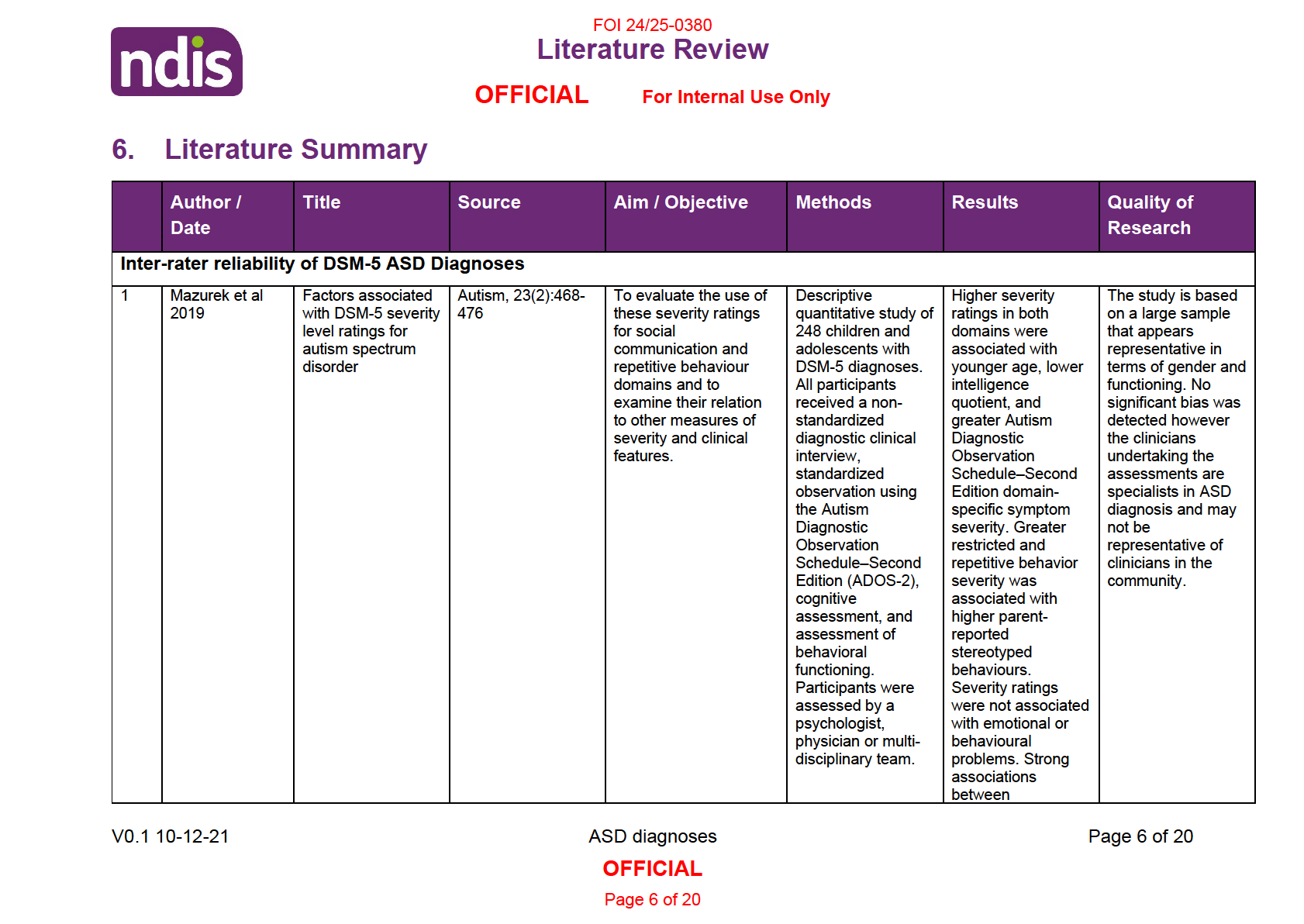
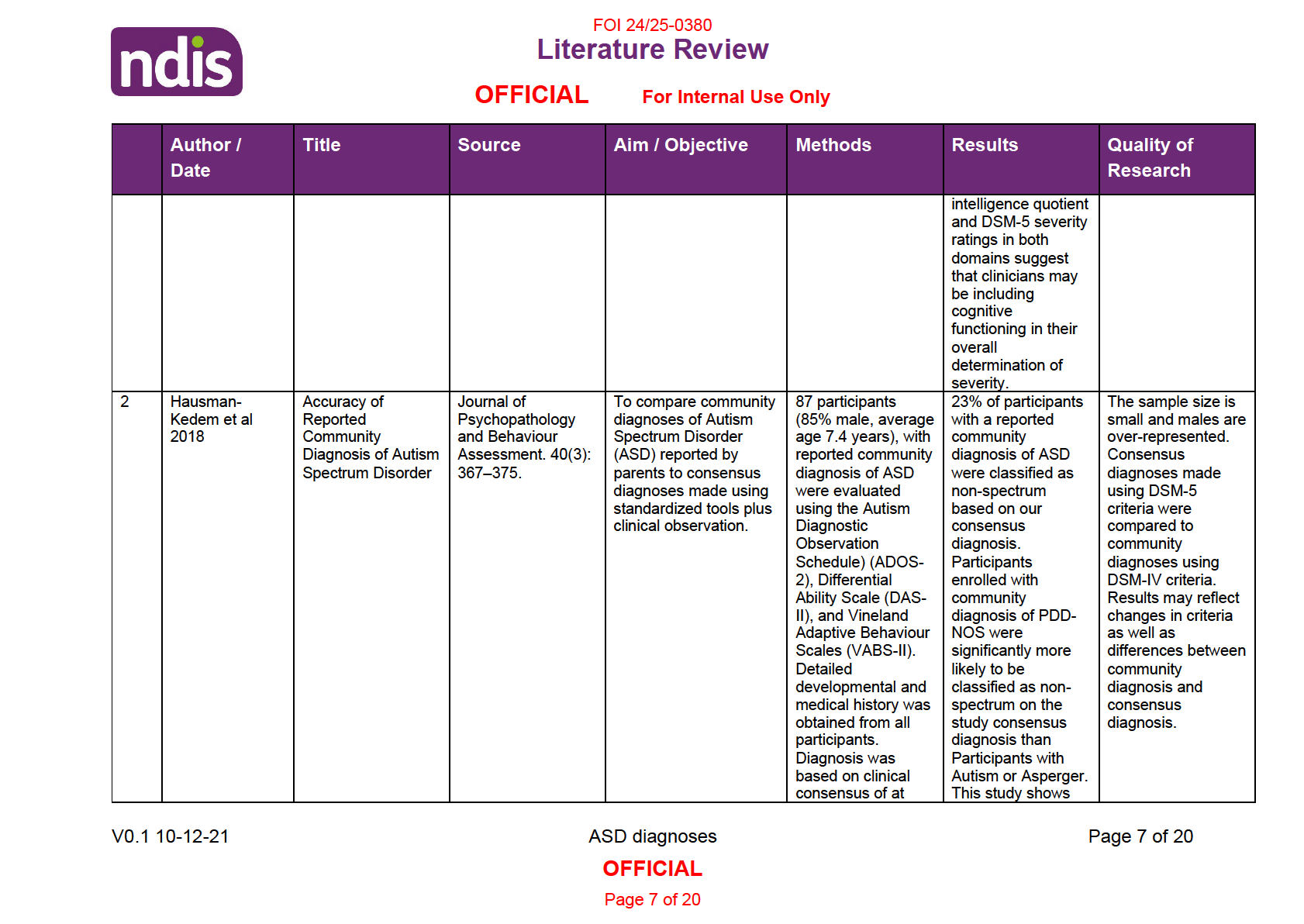
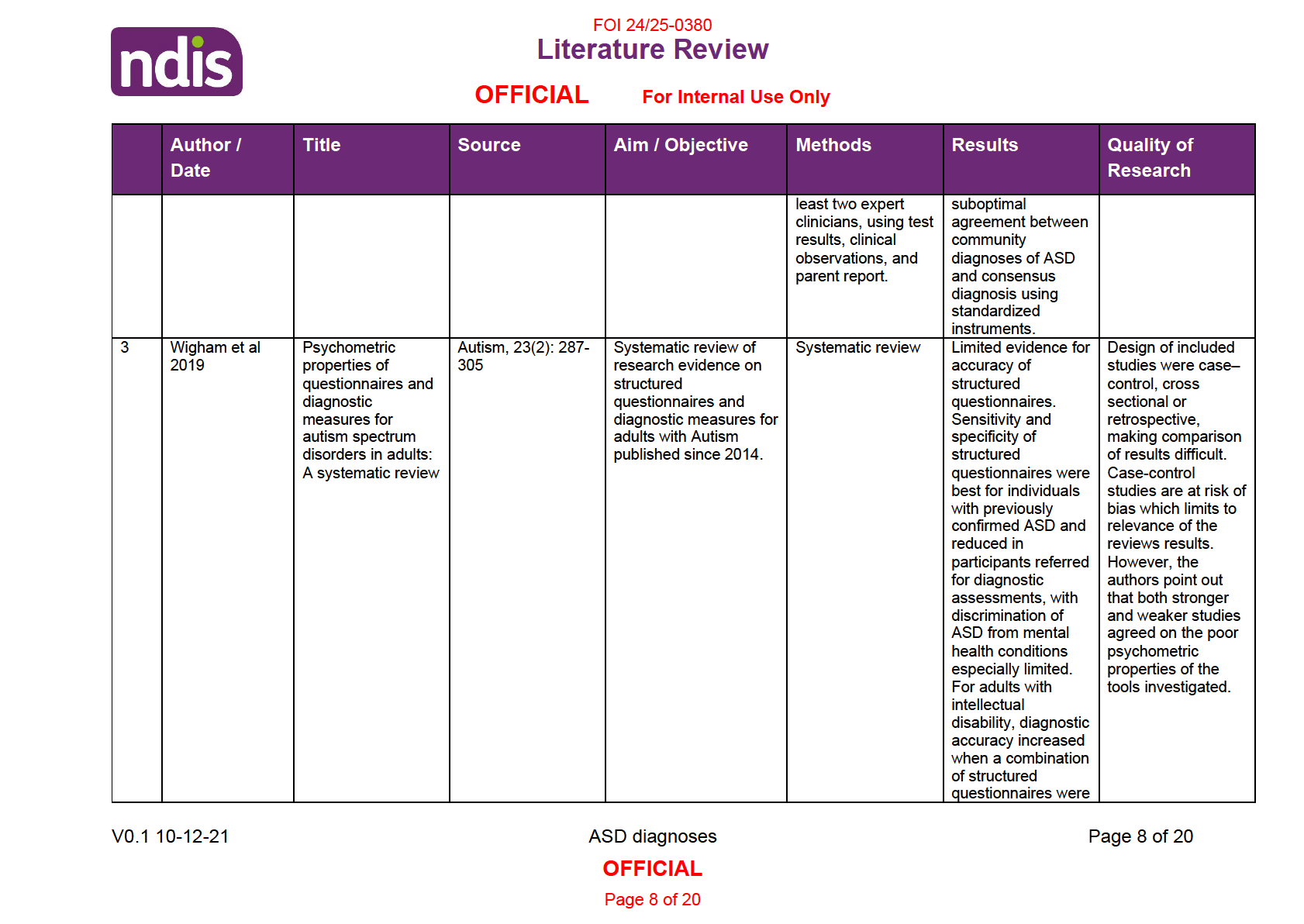
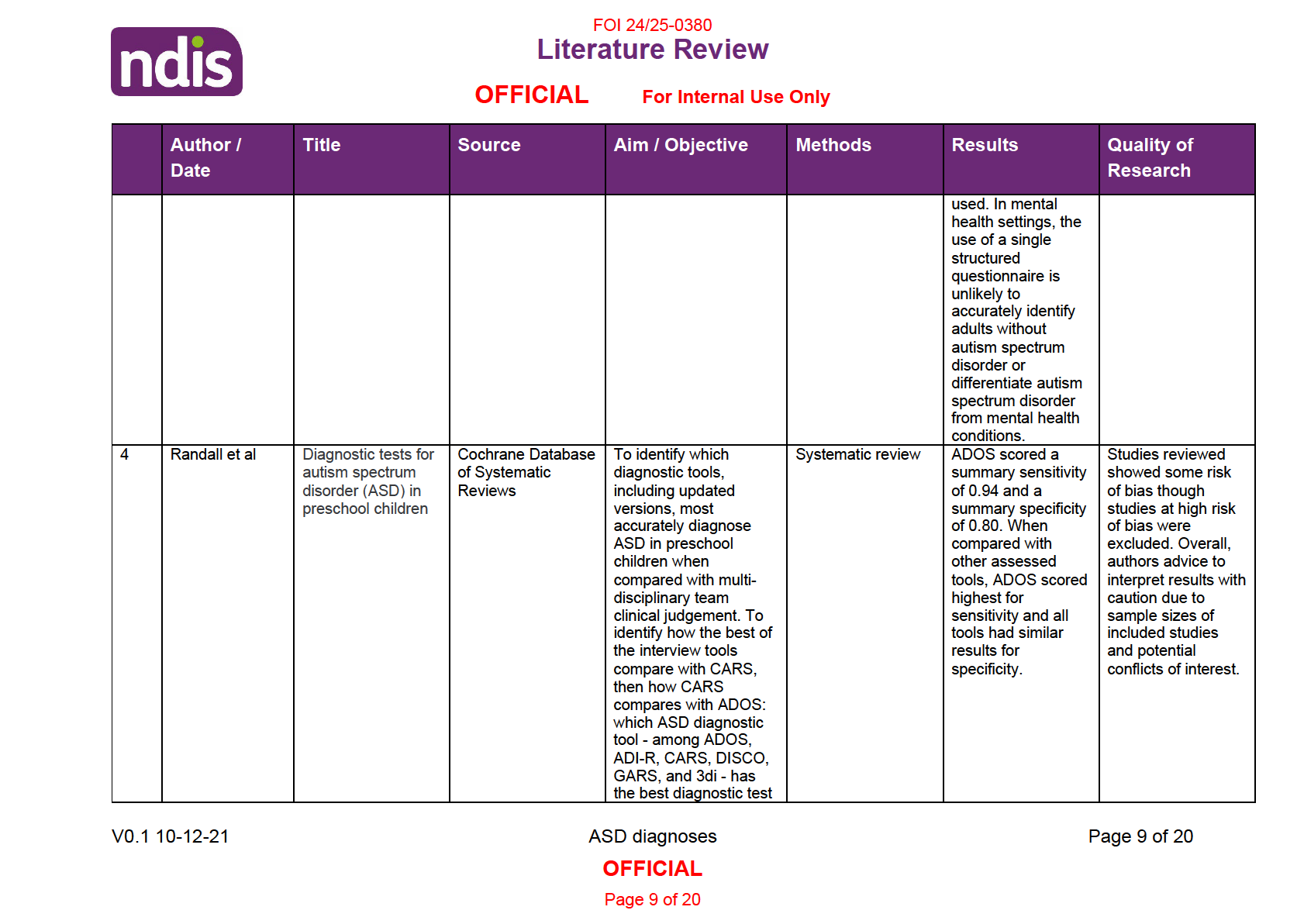
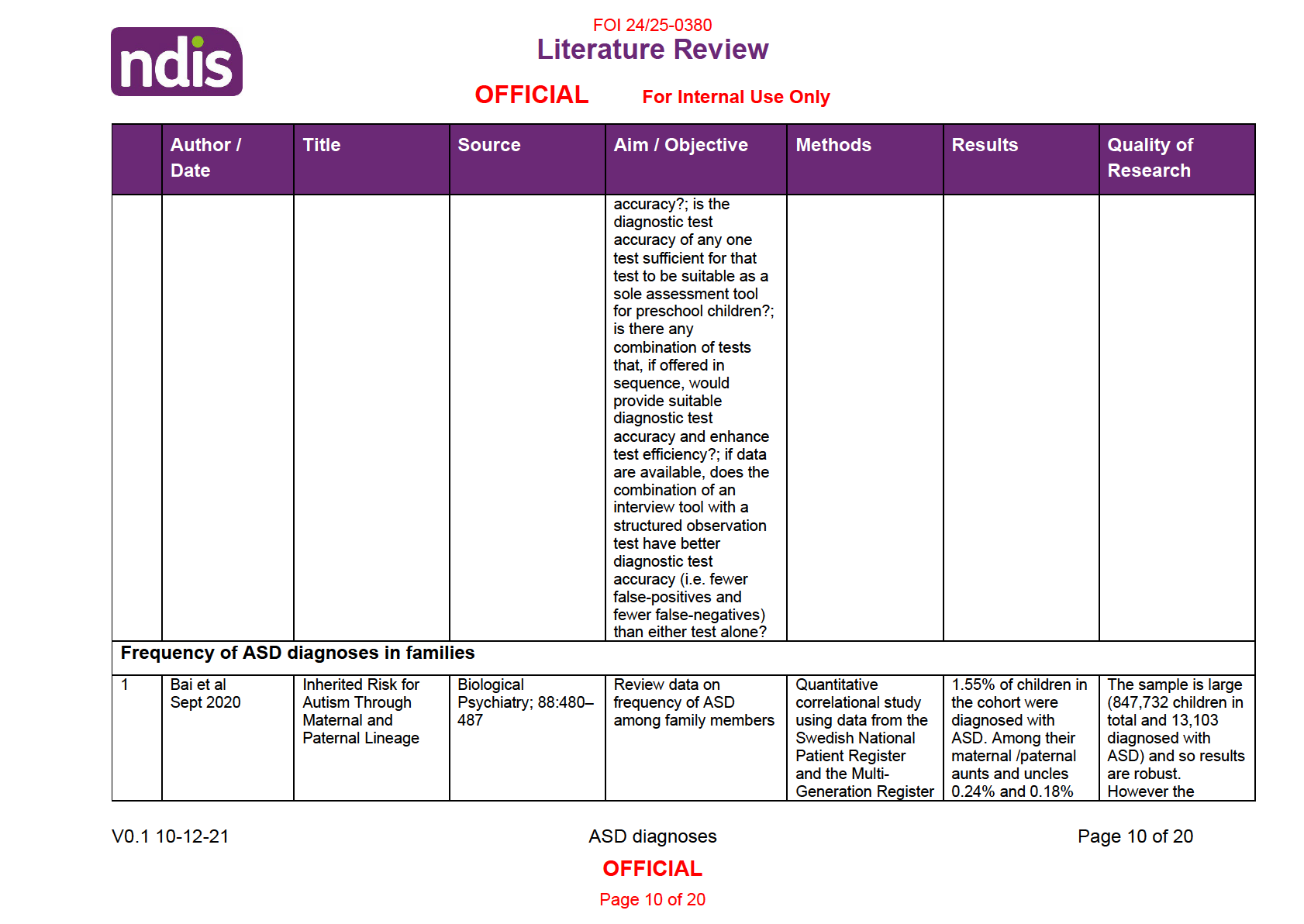

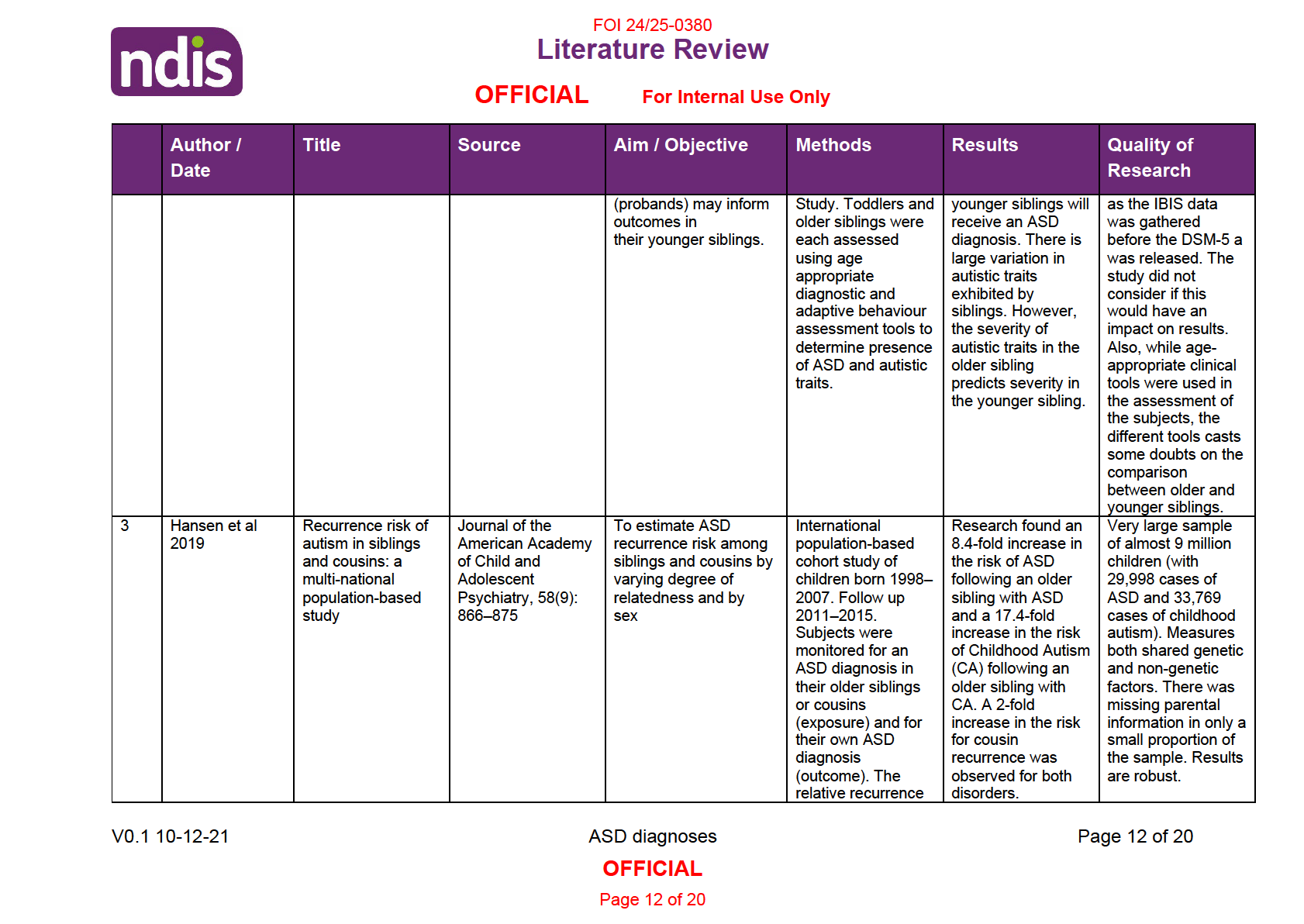
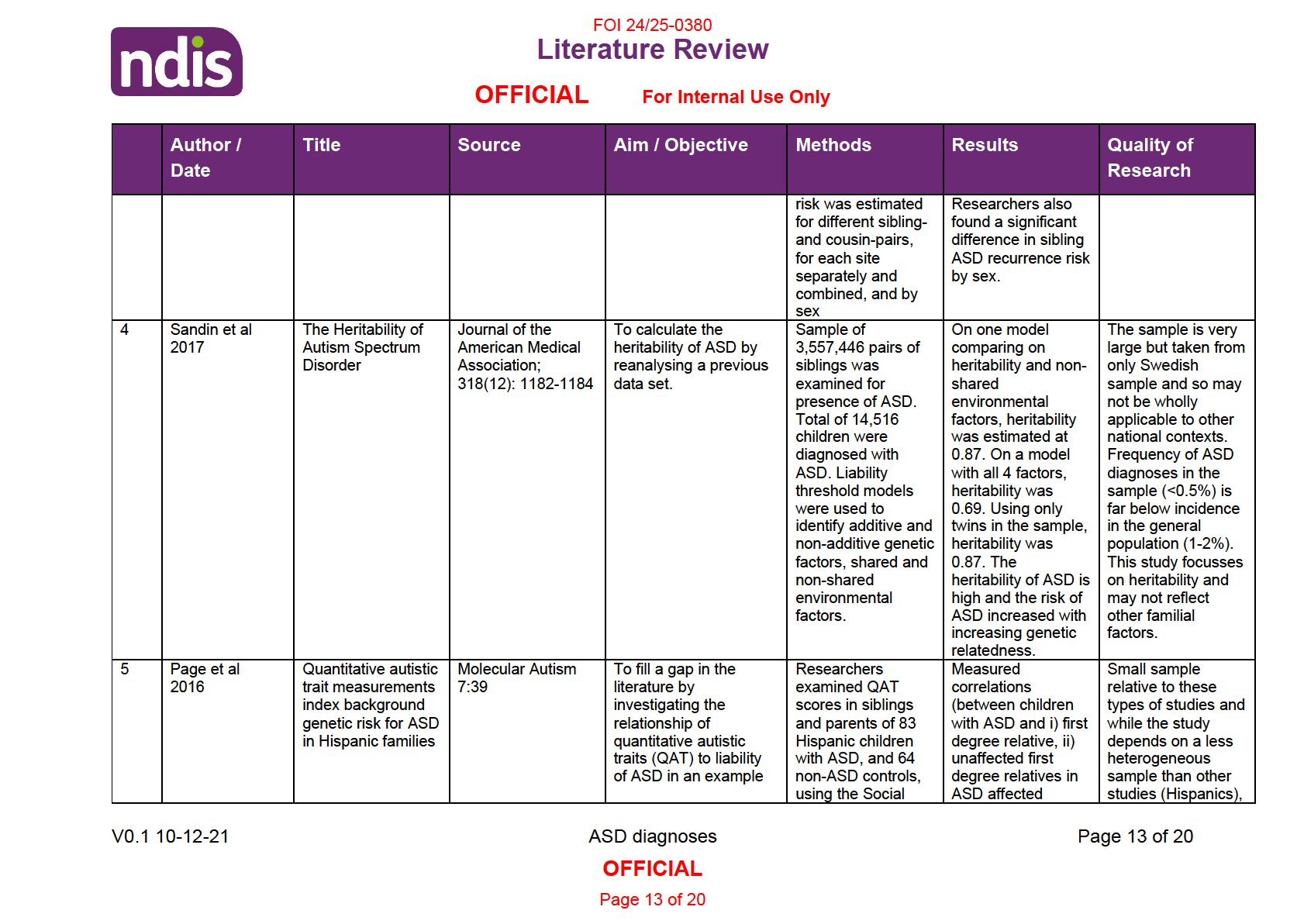
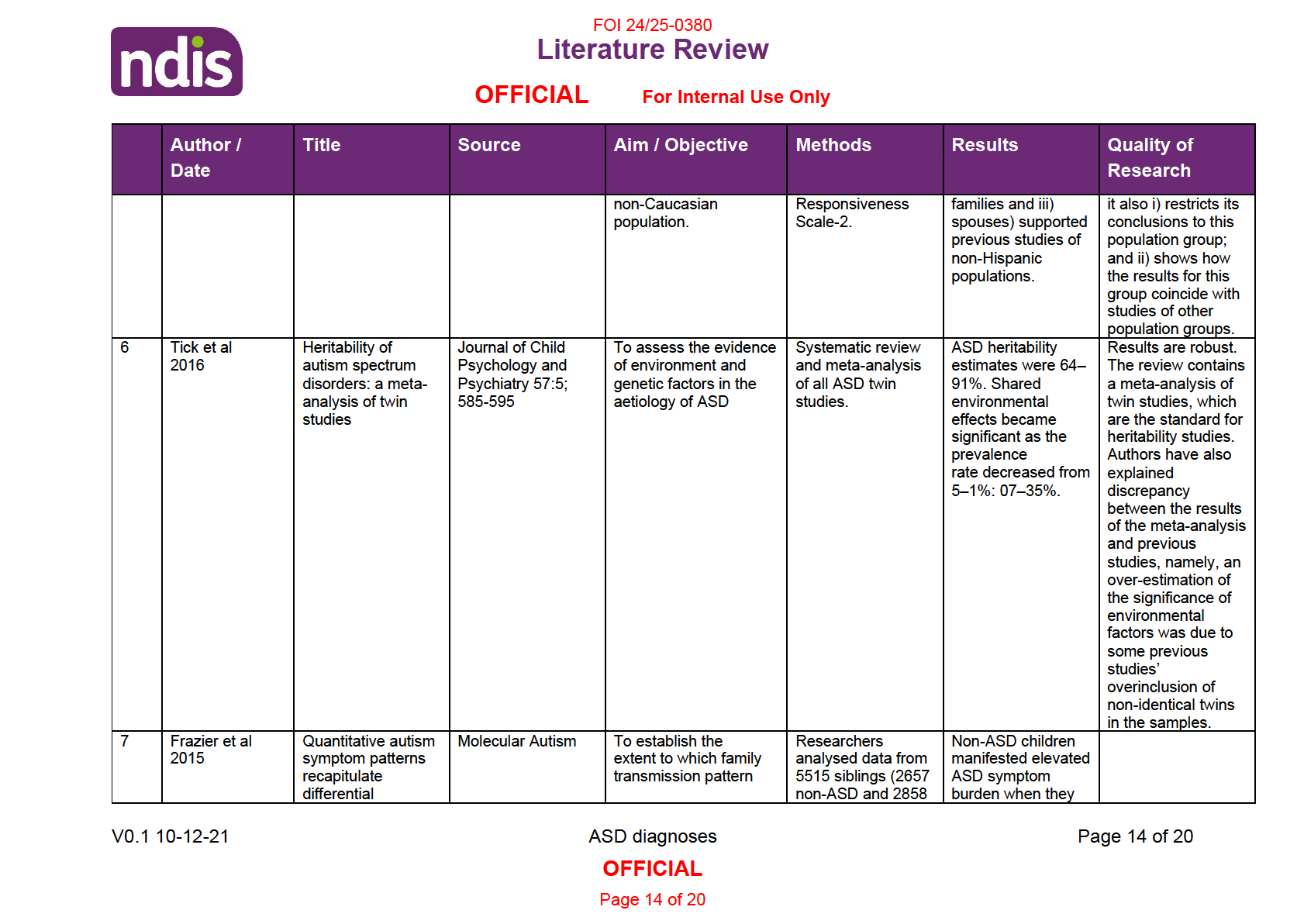
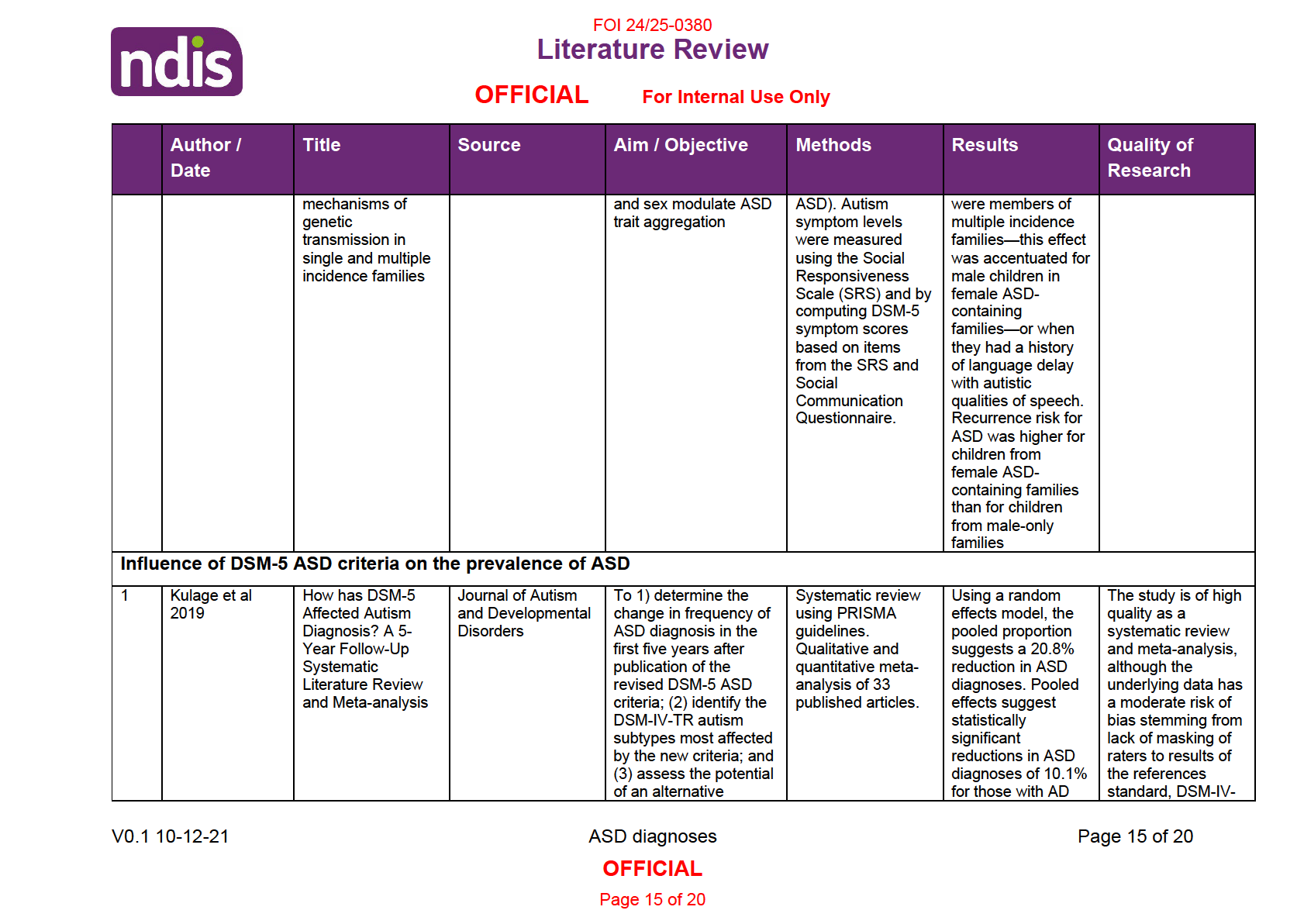
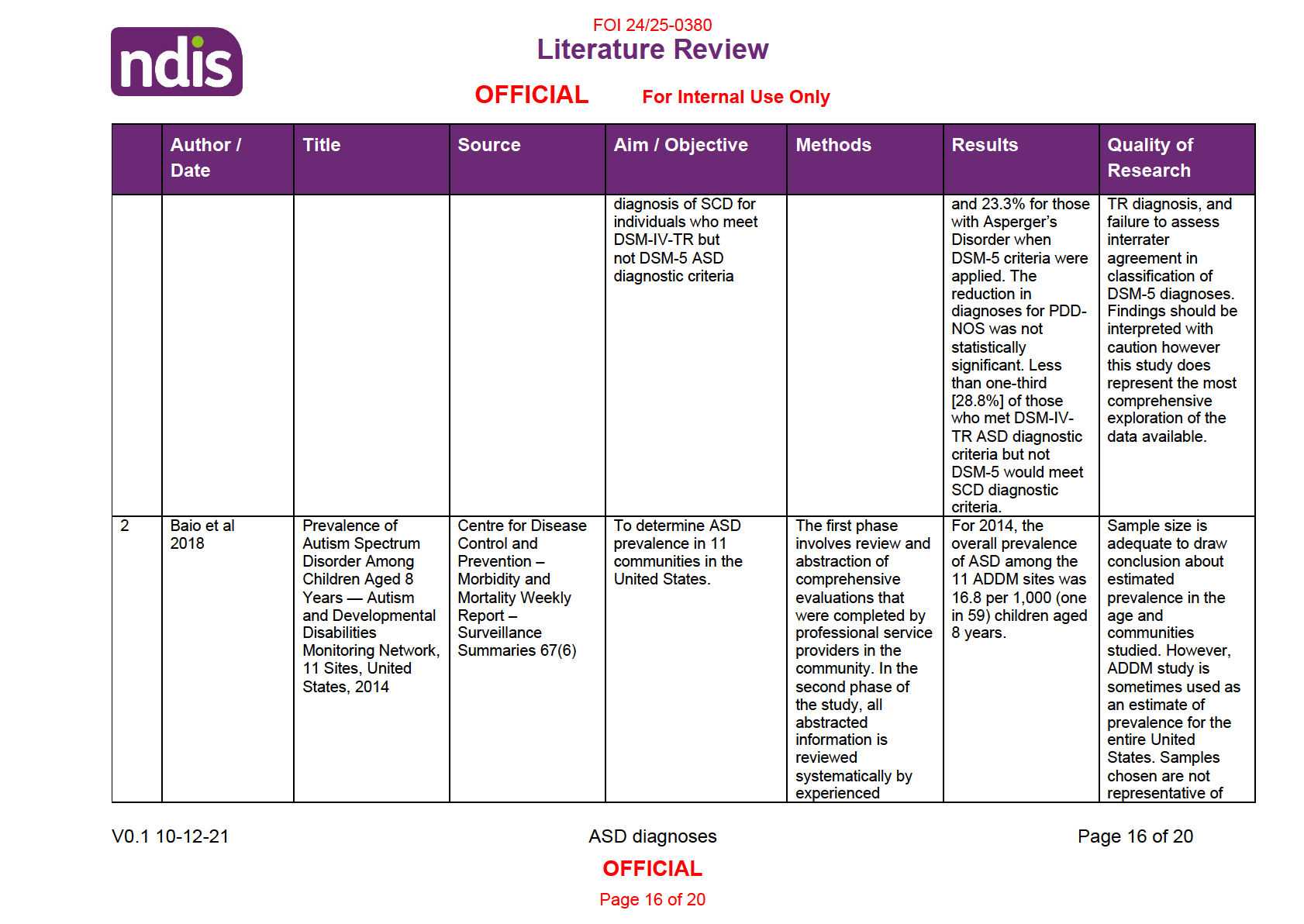
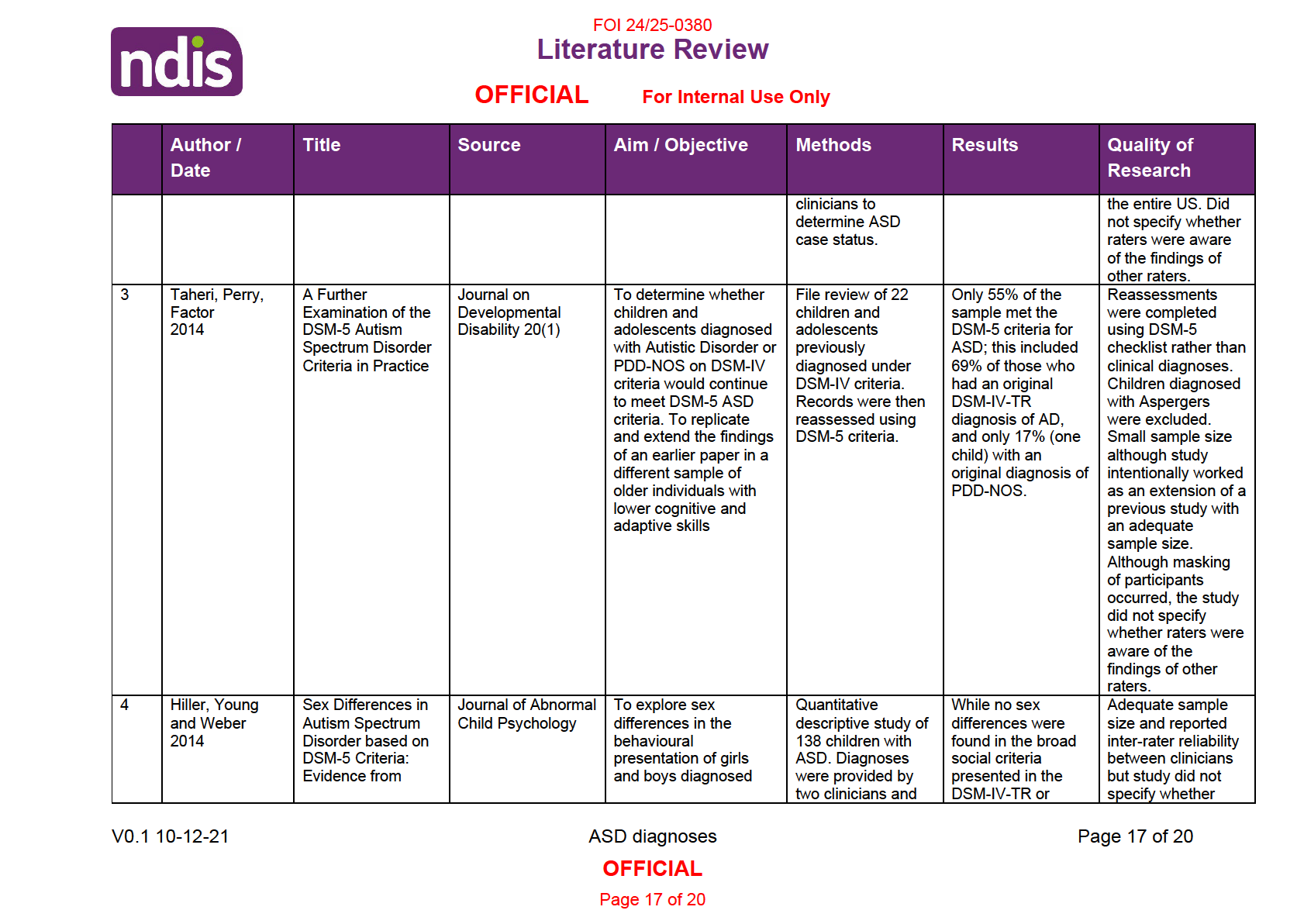
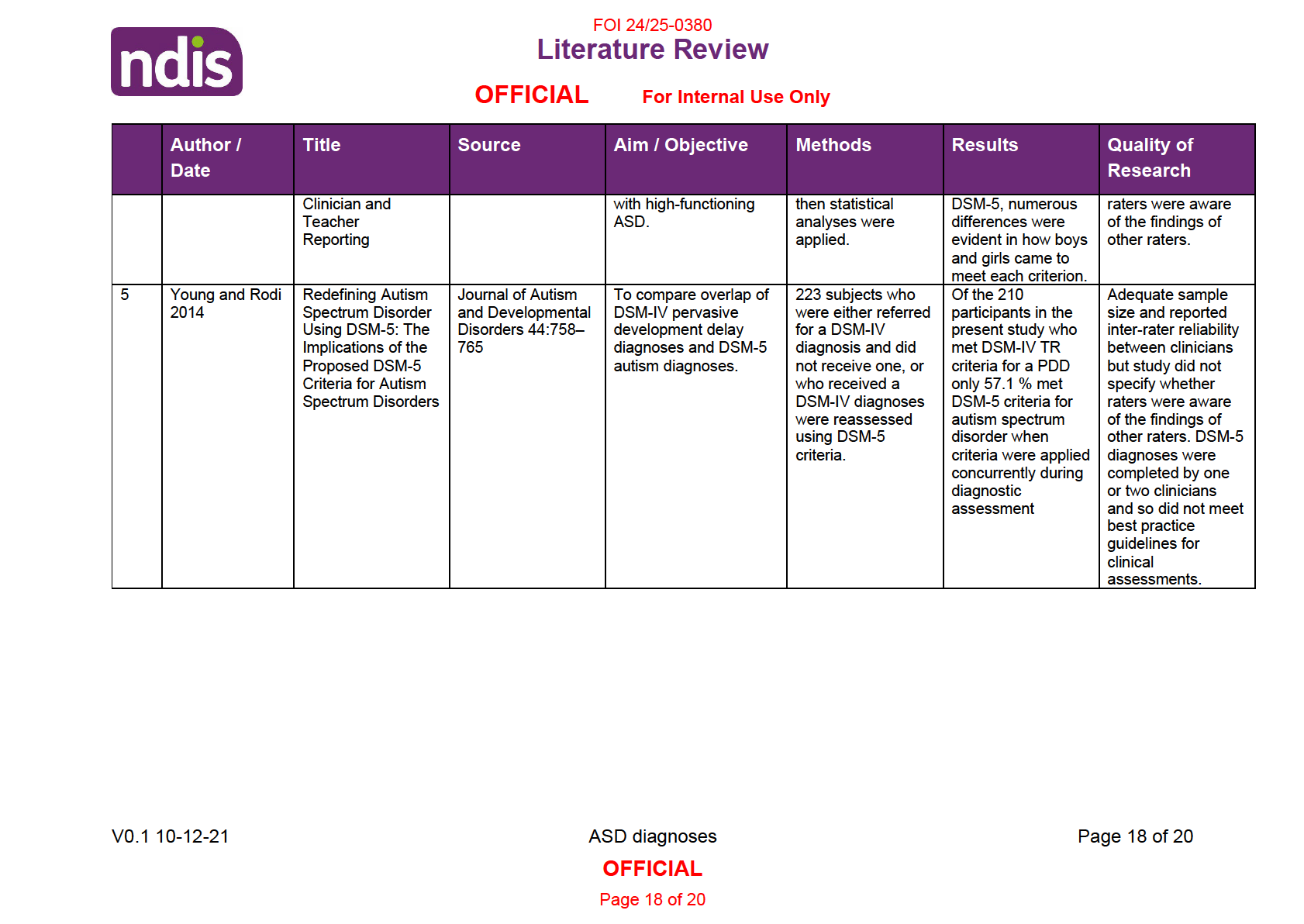

FOI 24/25-0380
Literature Review
OFFICIAL
For Internal Use Only
7. References
Autism Spectrum Australia (2018)
Autism prevalence rate up by an estimated 40% to 1 in 70
people. Autismspectrum.org.au. Available at: https://www.autismspectrum.org.au/news/autism-
prevalence-rate-up-by-an-estimated-40-to-1-in-70-people-11-07-2018 (Accessed: December
9, 2021).
Bai, D.
et al. (2020) “Inherited risk for autism through maternal and paternal lineage,”
Biological psychiatry, 88(6), pp. 480–487.
Baio, J.
et al. (2018) “Prevalence of autism spectrum disorder among children aged 8 years -
autism and Developmental Disabilities Monitoring Network, 11 sites, United States, 2014,”
MMWR Surveil ance Summaries, 67(6), pp. 1–23
Centre for Disease Control and Prevention (2020)
Autism prevalence studies data table,
Cdc.gov. Available at: https://www.cdc.gov/ncbddd/autism/data/autism-data-table.html
(Accessed: December 9, 2021).
Chiarotti, F. and Venerosi, A. (2020) “Epidemiology of autism spectrum disorders: A review of
worldwide prevalence estimates since 2014,”
Brain sciences, 10(5)
Downes, S. M. and Matthews, L. (2020) “Heritability,”
The Stanford Encyclopedia of
Philosophy. Spring 2020. Edited by E. N. Zalta. Metaphysics Research Lab, Stanford
University.
Girault, J. B.
et al. (2020) “Quantitative trait variation in ASD probands and toddler sibling
outcomes at 24 months,”
Journal of neurodevelopmental disorders, 12(1), p. 5.
Hansen, S. N.
et al. (2019) “Recurrence risk of autism in siblings and cousins: A multinational,
population-based study,”
Journal of the American Academy of Child and Adolescent
Psychiatry, 58(9), pp. 866–875.
Hausman-Kedem, M.
et al. (2018) “Accuracy of reported community diagnosis of Autism
Spectrum Disorder,”
Journal of psychopathology and behavioural assessment, 40(3), pp. 367–
375. doi: 10.1007/s10862-018-9642-1.
Hiller, R. M., Young, R. L. and Weber, N. (2014) “Sex differences in autism spectrum disorder
based on DSM-5 criteria: evidence from clinician and teacher reporting,”
Journal of abnormal
child psychology, 42(8), pp. 1381–1393. doi: 10.1007/s10802-014-9881-x.
Kulage, K. M.
et al. (2020) “How has DSM-5 affected autism diagnosis? A 5-year follow-up
systematic literature review and meta-analysis,”
Journal of autism and developmental
disorders, 50(6), pp. 2102–2127
Maenner, M. J.
et al. (2021) “Prevalence and characteristics of Autism spectrum disorder
among children aged 8 years - Autism and Developmental Disabilities Monitoring Network, 11
sites, United States, 2018,”
MMWR Surveillance Summaries, 70(11), pp. 1–16.
V0.1 10-12-21
ASD diagnoses
Page 19 of 20
OFFICIAL
Page 19 of 20
